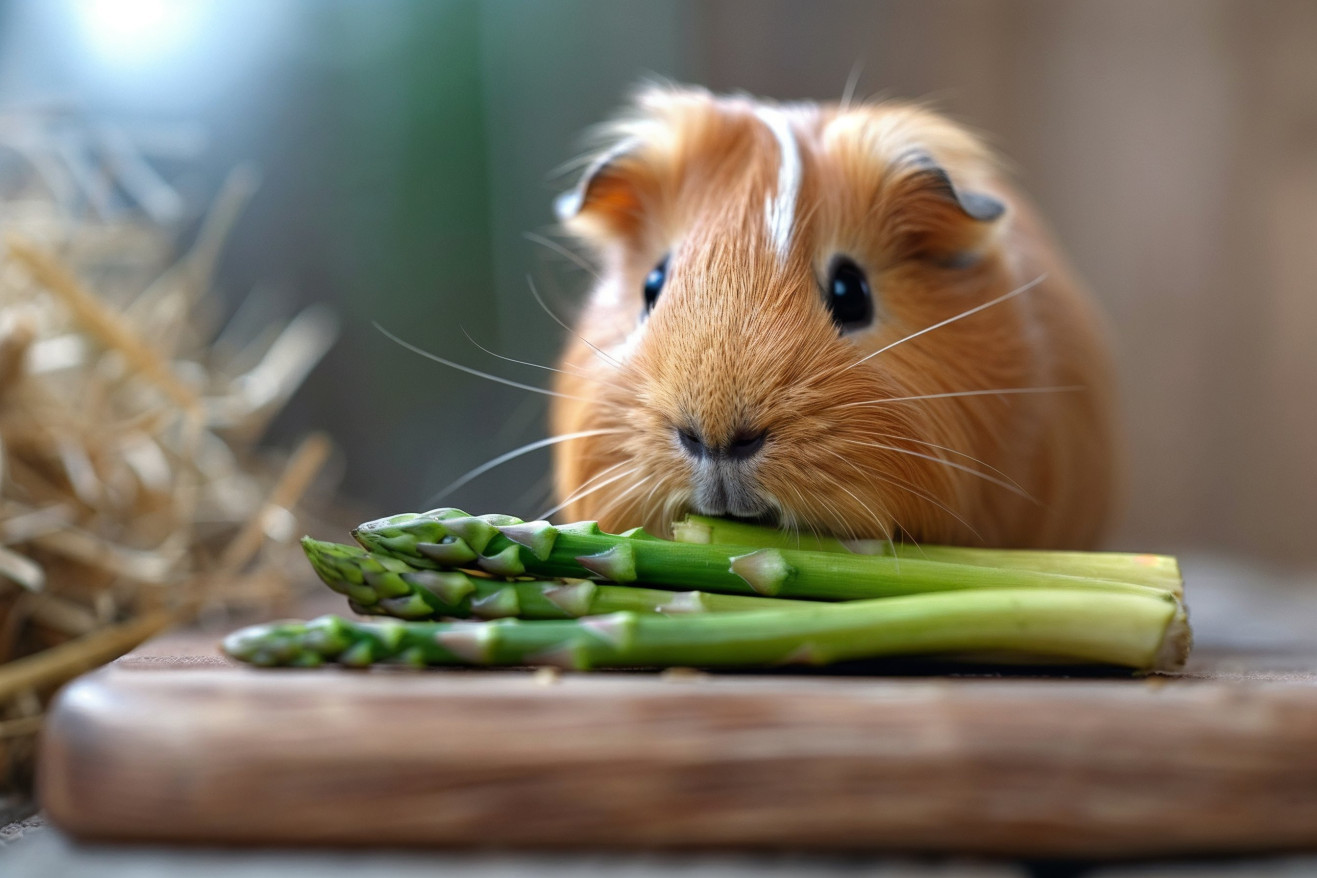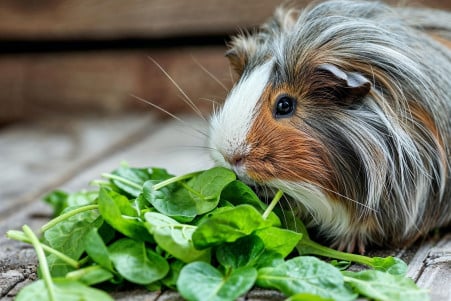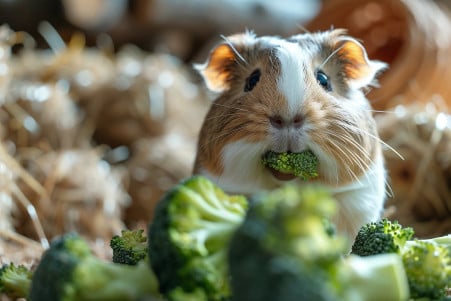Can Guinea Pigs Eat Asparagus? Safe Feeding Guidelines
16 February 2024 • Updated 16 February 2024

If you’re thinking about what treats to give your guinea pig, you may be wondering about asparagus. The good news is that guinea pigs can eat asparagus, but there are some things to keep in mind.
You can feed it to your pet raw and make sure it’s been washed well. You can feed it to them one to two times a week, but make sure to cut it into small pieces to avoid choking.
Asparagus has a lot of great nutrients, but it also has calcium and oxalates, so it’s important to make sure you’re giving it to your guinea pig in conjunction with other vegetables.
This article will go into the nutritional and veterinary science research that forms the basis of guinea pigs’ dietary requirements. It will look at the vitamins, minerals, and other things that make up a guinea pig’s diet and discuss where asparagus comes into play.
It will also talk about the best ways to introduce new foods to guinea pigs so that you can make sure you’re keeping them safe while also keeping their diet interesting.
Can guinea pigs eat asparagus?
Meeting the Nutritional Needs of Guinea Pigs
Guinea pigs are herbivores and their diet should be based on a variety of plant-based foods. Their digestive systems are adapted to a diet of fibrous plant material and they need a constant supply of high-quality hay to keep their teeth and gut healthy.
In addition to hay, guinea pigs need to get certain essential nutrients from their diet, including vitamin C, fiber, and various minerals, according to the Nutrient Requirements of the Guinea Pig from the NCBI Bookshelf.
One of the most important things to know about guinea pig nutrition is that, unlike many other animals, guinea pigs can’t make their own vitamin C, and if they don’t get enough in their diet, they can develop scurvy, according to VCA Animal Hospitals. This means that guinea pigs need to get vitamin C from their diet every day, in addition to eating low-calcium hay and vitamin C–rich vegetables.
The RSPCA Knowledgebase also notes that guinea pigs need a variety of fresh greens and vegetables to meet their hydration, vitamin, and enrichment needs. However, it’s important to feed them these foods in moderation to avoid digestive problems.
It’s important to make sure that guinea pigs get a balanced diet that includes a variety of nutrients. Asparagus can help with this because it provides important vitamins and minerals while also giving guinea pigs some variety in their diet.
Asparagus in a Guinea Pig’s Diet
Asparagus is in season in the spring and provides guinea pigs with a variety of important nutrients. According to Guinea Pig 101, asparagus is high in vitamins A, K, C, and B9 (folate), as well as fiber and antioxidants like anthocyanins. These nutrients help guinea pigs stay healthy by supporting their immune system, eyesight, and protecting them from diseases like scurvy—especially important since guinea pigs, like humans, can’t synthesize their own vitamin C.
Guinea Pig Center says that asparagus can be added to a guinea pig’s diet with some care. The site recommends that a good portion size is about a quarter cup of asparagus, which can be given once or twice a week. Asparagus should be fed to guinea pigs raw, after being washed and cut into small pieces to prevent choking and make it easier for the guinea pig to eat.
However, asparagus is high in calcium and oxalates, which can cause problems if guinea pigs eat too much of it. Guinea pigs that eat too much asparagus can develop bladder stones, which can be life-threatening.
So while asparagus can be a healthy and hydrating addition to a guinea pig’s diet—since it’s more than 90% water—it’s important to make sure that guinea pigs eat it in moderation and that it’s balanced with other foods to avoid these problems.
How to Balance Calcium and Oxalate in Your Guinea Pig’s Diet
Both calcium and oxalate are important for guinea pigs, but high levels of either can lead to health problems, including bladder stones. Bladder stones, or urolithiasis, are a common problem in guinea pigs, and calcium salts, especially calcium oxalate, are the most common components of these stones.
Calcium is important for bone and teeth health, muscle contractions, and nerve function, according to GuineaDad, but too much of it can cause painful urinary deposits and even life-threatening bladder stones.
This is why it’s important to make sure your guinea pig’s diet includes the right calcium to phosphorus ratio, which should be 1.5:1 or lower, according to The Guinea Pig Vet. This can be achieved by feeding your guinea pig a variety of vegetables and being mindful of high-calcium options like asparagus.
A case study published in PMC found that high oxalate intake led to renal failure in guinea pigs, which shows the risks of high oxalate levels and the importance of making sure your guinea pig’s diet is well-balanced.
So, take the nutritional information of asparagus into account and adjust your guinea pig’s diet as needed to make sure they don’t experience any health problems from eating this vegetable. This way, you can make sure your guinea pig gets the benefits of asparagus without the risks, and you can continue to offer them a varied and healthy diet.
How to Introduce Asparagus to Your Guinea Pig
Like with any new food, it’s important to be cautious when introducing asparagus to your guinea pig. GuineaDad recommends starting with a small amount and monitoring your guinea pig for any adverse reactions. You can do this by giving your guinea pig a small piece of asparagus and then watching them for 24 hours to see if they experience any digestive issues.
Burgess Pet Care notes that any changes in a guinea pig’s diet, including the introduction of fresh vegetables like asparagus, should be made over a period of two to four weeks to avoid any potential digestive problems. To do this, gradually introduce the new food by adding a small amount to their regular food and then increasing the amount of the new food each day.
Throughout this process, it’s important to keep a close eye on your guinea pig to see if they experience any changes in their eating habits, stool, or any other signs of distress.
The RSPCA explains that guinea pigs have delicate digestive systems, so it’s important to monitor them closely when introducing new foods. If your guinea pig does experience any adverse reactions, such as diarrhea or a lack of energy, it’s important to contact your veterinarian.
By following these steps, you can safely introduce asparagus and other new foods to your guinea pig, ensuring that they stay healthy and happy.
Conclusion: Asparagus and Your Guinea Pig’s Diet
In conclusion, guinea pigs can safely eat asparagus. Asparagus is a fibrous vegetable that offers a variety of vitamins, including vitamins A, K, C, and B9, to your guinea pig’s diet.
The important thing to remember is that it should be fed in moderation. Small amounts of raw asparagus can be fed to guinea pigs, but it should be introduced slowly and fed only once or twice a week to avoid overloading your pet with calcium and oxalates—both of which can cause health problems like bladder stones when consumed in excess.
To ensure that the diet maintains the proper calcium to phosphorus ratio for urinary health, make sure to feed a variety of other vegetables that are compatible with asparagus. You can also make sure that you’re feeding your guinea pig a well-rounded diet and keeping an eye on how they react to new foods by introducing changes gradually and watching for any negative symptoms.
In summary, make sure that you’re providing good care for your guinea pig by staying informed and working with your vet to get personalized nutritional guidance. Include asparagus as part of a well-rounded diet, and you can feel good about keeping your guinea pig healthy.


